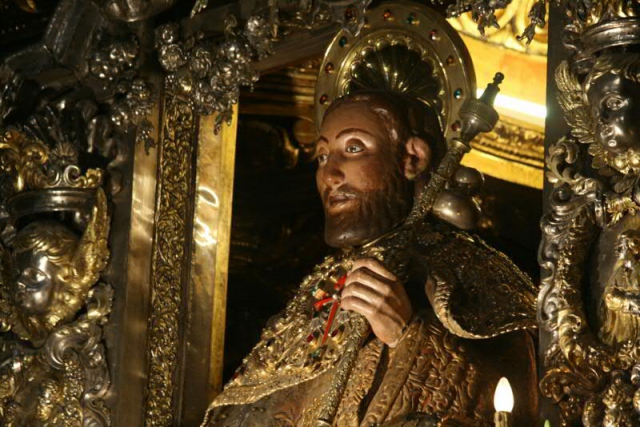Hugging the Apostle Santiago: Where does the tradition come from?
Throughout the years, pilgrims have finished the Camino embracing the Apostle St. James, but where does this tradition originate?
When walking the Camino de Santiago, there are many traditions that are lived regardless of the route we take. Not only the burning of the boots at the end of the road or even leaving stones and crosses along the way stands out. It is also known one of the traditions that, in recent years, has been paralyzed by the pandemic and that takes as a gesture to embrace the Apostle Santiago.
There are thousands and thousands of people who, throughout the year, agree to perform this Jacobean ritual with excitement. However, when was the decision taken to implement it? When was this first embrace made? You should know that its history goes back many centuries, exactly to the 13th century.
What does it mean to embrace the Apostle James?
This Jacobean tradition that is lived with great excitement has its origins in the thirteenth century, exactly at the time when the works were completed in the cathedral in the year 1211. Why did the birth of this tradition take place then and not before? Everything is due to the desire of the pilgrims to feel the physical proximity of Santiago after the effort made during the pilgrimage.
Although there are many legends that speak about this statue being made of a type of stone that helps to recover energy after the journey, the reality is that the embrace has a more symbolic meaning. With this the pilgrim feels that the Apostle welcomes him, welcoming him home.
It is a gesture full of affection and even intimate, causing some of the pilgrims to take this gesture as an opportunity to make a wish. However, not everyone sees it as a gesture of welcome, but as a physical way to end the stage of the road.
However, there are those who do not limit themselves to embrace the Apostle. For all those who make the way and are in the Plaza del Obradoiro, you can see that the embrace is also made between the pilgrims who have made the way together. A way of not only showing the enthusiasm of the experience, but also the affection as well as the end of that stage.
The origin of the embrace of the Apostle St. James
As we indicated above, the origin of this tradition was born at the end of the works in the cathedral and, since then, the tradition has remained intact. The sculpture was placed on the main altar, as a way of transforming the place in which pilgrims as well as visitors to the cathedral could move around.
It was at that time when the pertinent measures were taken to regulate the opening of the gates where the sculpture is located. In this way, the access of the pilgrims was controlled so that they could deliver the alms as well as give their hugs; a gesture that was maintained until 2020 when the bishops replaced the hug with a bow. A measure taken due to the pandemic and the need to take extreme precautions.
However, before these measures were imposed, the tradition varied in small ways. For example, while in the Middle Ages visitors murmured to the pilgrim, a very common gesture among French pilgrims. At the same time, the custom of placing the crown of the Apostle on the pilgrims' heads, a gesture that was taken as a sign of pride in having completed the pilgrimage, also disappeared.
The appearance of the sculpture of St. James the Apostle
All those pilgrims or visitors to the cathedral who have the opportunity to see it, are aware of the imposing size of the statue. It is a sculpture created in polychrome stone from the workshop of Master Mateo and that, after the conclusion of the works of 1211, it was decided to place it on the main altar.
This one has a series of particularities. Among them, it is possible to emphasize the fact that the Apostle is represented with mature aspect, which stands out with the presence of beard and mustache. This in turn is presented enthroned by bringing him cartouche and báculo, which ended in the form of tau.
This last aspect stands out due to the fact that the tau-shaped bishopric was an exclusive attribute of the archbishops of Compostela as descendants of the apostles. Therefore, this representation was intended to be pontifical.
Of course, the passage of time brought certain changes to the sculpture, highlighting the changes of the baroque era. It was here where the nimbus, the slavina, the new bá ass for the Apó stol and the silver throne were added. A series of elements that, to this day, can be seen in their current position.
Routes
Blog
 How to get to Sarria to do the Camino de Santiago
How to get to Sarria to do the Camino de Santiago
 Descubre la magia del Camino de Santiago Portugués por la costa
Descubre la magia del Camino de Santiago Portugués por la costa
 5 tours culturales que puedes hacer en Galicia si decides hacer un alto en el camino
5 tours culturales que puedes hacer en Galicia si decides hacer un alto en el camino
 Doing the Camino de Santiago in June: What you should know?
Doing the Camino de Santiago in June: What you should know?
Information
Points of interest
Cities & Towns | Hostels | Lodgings | Restaurants | Saddlery | Doctors | Points of interest | Bikes workshop
Contact us | Privacy policy | Cookies policy | | Terms of use | Authorship | Web Map | Consentimiento
© Copyright LA VOZ DE GALICIA S.A. Polígono de Sabón, Arteixo, A CORUÑA (ESPAÑA) Inscrita en el Registro Mercantil de A Coruña en el Tomo 2438 del Archivo, Sección General, a los folios 91 y siguientes, hoja C-2141. CIF: A-15000649
Developed and managed byHyliacom
